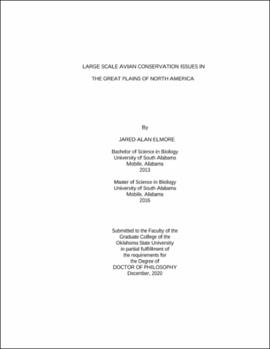| dc.contributor.advisor | Loss, Scott R. | |
| dc.contributor.author | Elmore, Jared Alan | |
| dc.date.accessioned | 2021-05-25T20:32:02Z | |
| dc.date.available | 2021-05-25T20:32:02Z | |
| dc.date.issued | 2020-12 | |
| dc.identifier.uri | https://hdl.handle.net/11244/329909 | |
| dc.description.abstract | Globally many bird populations are declining at a rapid pace due to direct and indirect anthropogenic disturbances. Bird collisions with buildings are one major source of direct mortality. Chapter 1 examined species- and life-history-related variation and correlates of collisions at 40 sites across 3 North American countries. Many of the top 10 most vulnerable species were consistent with other broad scale studies but several emerged for the first time. Building size and glass area were positively correlated for most species and vegetation around buildings was negatively correlated with one species. Life history characteristics of species being migrants, insectivores, and woodland inhabitants also predicted collisions. Chapter 2 assessed the use of radar for predicting numbers of bird-building collisions in Stillwater, Oklahoma. Across the entire night, higher migration traffic rate and lower flight height were associated with increased collisions, and migration variables for periods within the night were also related to collisions. Habitat loss is a major source of indirect mortality to birds, especially in wetland and grassland systems such as the Great Plains. Chapter 3 evaluated broad and fine scale wetland habitat use by different migratory shorebird species in north central Oklahoma. There was variation among broad scale wetland use, with most species selecting for a 500m spatial scale, and most species being fairly similar among fine scale predictors. However, there was variation in effect size across predictors, suggesting that for most shorebirds, efforts to conserve and restore wetlands should focus heterogeneity of wetlands both in terms of habitat availability at both broad and fine scales. Chapter 4 reviewed bird response to fire in North American Grasslands. Most studies focused on prescribed fire and did not evaluate crucial factors that influence ecosystem response to fire. Most studies also only assessed effects of fire during avian breeding seasons. Further most studies were conducted in only prairie or savanna. Overall our findings provide novel insight into important direct and indirect contributions to bird mortality and can be used to help curve global bird population declines. | |
| dc.format | application/pdf | |
| dc.language | en_US | |
| dc.rights | Copyright is held by the author who has granted the Oklahoma State University Library the non-exclusive right to share this material in its institutional repository. Contact Digital Library Services at lib-dls@okstate.edu or 405-744-9161 for the permission policy on the use, reproduction or distribution of this material. | |
| dc.title | Large scale avian conservation issues in the Great Plains of North America | |
| dc.contributor.committeeMember | Davis, Craig A. | |
| dc.contributor.committeeMember | Fuhlendorf, Sam D. | |
| dc.contributor.committeeMember | Baum, Kristen A. | |
| osu.filename | Elmore_okstate_0664D_16906.pdf | |
| osu.accesstype | Open Access | |
| dc.type.genre | Dissertation | |
| dc.type.material | Text | |
| dc.subject.keywords | bird | |
| dc.subject.keywords | collisions | |
| dc.subject.keywords | fire | |
| dc.subject.keywords | habitat | |
| dc.subject.keywords | mortality | |
| dc.subject.keywords | radar | |
| thesis.degree.discipline | Natural Resource Ecology and Management | |
| thesis.degree.grantor | Oklahoma State University | |
